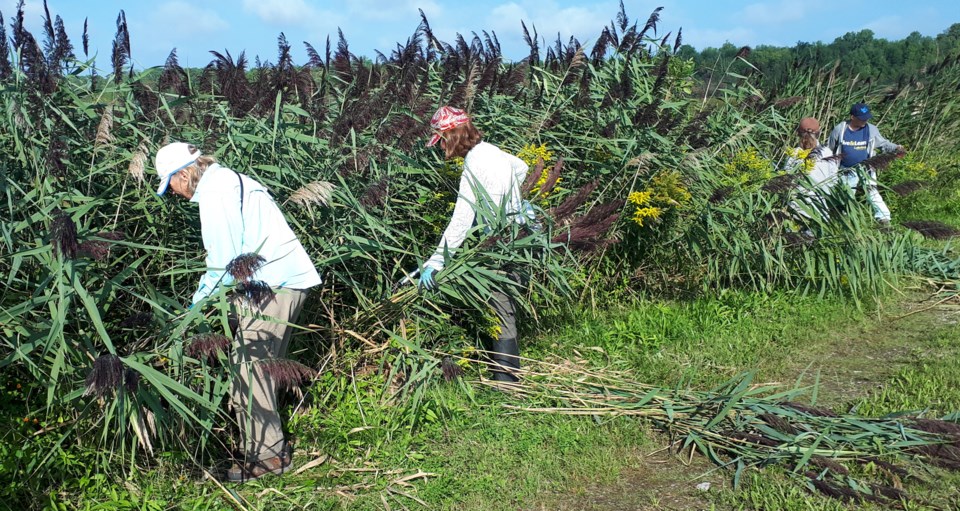In the world of dealing with invasive plants, winter is a welcome time for reflection, research, planning, and strategizing for the coming seasons.
Soon there will be ‘endless’ spring and summer days of pulling, picking, cutting and even spraying. Now is the time for the gathering of knowledge, sharing of experiences, and the preparation for deploying the troops of volunteers and summer staff.
Invasive plants catch our attention as they are, well, invasive: they arrive unexpectedly, infiltrate the local ecology, establish strongly rooted base camps, quickly begin displacing the native species, and within a few years have controlled complete dominance over a local wetland, woodland or grassland. However sneaky you may think these plants, you do have to shed a bit of respect for their thorough efficiency.
However, we who think the landscape should remain in as close to a natural balance as possible, have established resistance fighters. Across the province we have established cells of enthusiastic volunteers who relentlessly assault the established strongholds of garlic mustard, dog-strangling vine, buckthorn shrubs, and Phragmites reed.
Within our collective toolbox of weapons of mass destruction are included sturdy work gloves, black plastic garbage bags, garden loppers, gas-powered hedge trimmers, chemicals (very carefully deployed, of course), and now ... bio-controls!
While bio-controls may sound mysterious and futuristic, it is a method of controlling invasives used since at least 1951. A bio-control agent is a living organism, be it a moth, weevil, beetle, or other beastie. Bio-control programs are the act of deliberately introducing a living predator into the local landscape to seek out and destroy the targeted invasive plant.
Sound ecologically nasty? It is. And it is a method that is very last resort. If the aforementioned cutting, pulling, pod collecting, root digging or even chemical applications have not had the desired effect of stopping the spread of, or even the density of, certain plant species, then (with wicked maniacal laugh?) open the jars and release the beasts!
OK, enough of my comic book-style theatrics.
As mentioned, bio-controls have been released in Ontario before; indeed since the early 1950s about 86 insects have been used to combat 35 different weeds, mainly in the agricultural sector. And yes, occasionally a couple of these ‘guardians’ have gone rogue and become a pest unto themselves. So caution, great caution, is required when contemplating such an action again.
In the late 1980s two foreign weevils were released to tackle the threat of purple loosestrife, a plant that was steadily taking over wetlands. (“Foreign weevils”… what a great name for a band. But I digress.) These weevils have done what they were sent out to do: reduce the vigor of the loosestrife, thereby reducing its rate of spread and density, thereby allowing native species to compete and retain their presence in the wetlands.
Now the concern is with Phragmites reed, that four-metre tall, thickly growing, large seed-headed invader. At first it hid amongst the native variety of Phragmites, but has now emerged as the province's No. 1 nasty, causing immense negative impacts on wetlands, and racking up huge financial costs to municipalities which are trying to get ahead of fire-fighting costs and ditch clearing expenses.
Despite the valiant efforts from many over the past couple of decades, Phragmites is still growing rampantly. We need a new tool in the toolbox, a new weapon of mass destruction.
A few things to keep in mind: bio-controls are deployed only after every other option is exhausted; and securing, researching, testing and releasing said bio-control is not a short form test. It takes years.
In the case of the two moths proposed to help control Phragmites, that project began in 1998. That’s right, 26 years to date. And now the researchers feel confident that such a release is feasible.
Twenty-six years? Why didn’t they just take a sweep net and grab a bunch of insects from a Phragmites patch in Europe, stuff them in a jar, and send them over to us to release? “Easy-peasy, job done.”
Thankfully, we have regulations in place that control the import of such plant-munching visitors. Yes, the intent is to re-introduce the invasive plant with a natural predator from the home world, but Ontario is very different than central Europe in many ways biological. For starters, the invasive European variety of Phragmites does not grow in the dense stands that it does here in Ontar-i-ar-io.
It took the first 10 years to see if the moths were plant-specific, meaning does the caterpillar eat other things if the Phragmites loses its appeal? From 46 possible insects that eat Phrag in Europe, only two moth caterpillars have been proven to be host-specific in North America.
However, there are few more things to be aware of, in case you may be thinking this will be the ‘silver bullet’ to kill off the Phragmites, because it will not. The best we can hope for is that the moths (more specifically their stem-boring caterpillars) will reduce the plant’s density to allow native plants to hold on and retain their place within the ecosystem.
The research is still ongoing, studying things like winter mortality and predation from everything from ants to red-winged blackbirds. Several test sites have already been established in southern Ontario, and considerations are now being discussed for southern Georgian Bay.
The meeting in which I attended (hosted by the Ontario Invasive Species Council) and learned the details of this project, was attended by a wide range of professional and experienced Phragmites fighters. Perhaps I can summarize the attitude of the group as ‘guarded optimism’; many questions were answered yet some anxiety and doubt remains.
Stay tuned and I’ll share new info as it becomes available.



